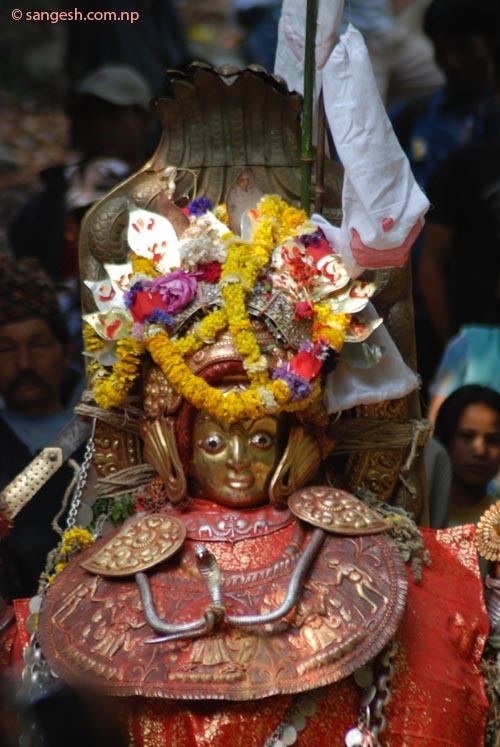 | ||
The Green Eye of the Yellow God is a 1911 poem by J. Milton Hayes that is a famous example of the genre of "dramatic monologue", which was a music hall staple in the early twentieth century. The piece was written for and performed by actor and monologist Bransby Williams.
Contents
The poem is influenced by the ballads of Rudyard Kipling and was often parodied, most famously by Billy Bennett as The Green Tie on the Little Yellow Dog.
The opening lines are still very well known:
There's a one-eyed yellow idol to the north of Khatmandu, There's a little marble cross below the town; There's a broken-hearted woman tends the grave of Mad Carew, And the Yellow God forever gazes down.It is set in Nepal ("to the north of" Kathmandu), and tells the tale of a wild young officer known as "Mad Carew", who steals the "green eye" of a "yellow god" (presumably an emerald in a gold statue) in order to impress his beloved. He is wounded in the course of the robbery, and later murdered, presumably by a devotee of the god for the theft, who returns the jewel to the idol.
Hayes's account
In his book My Brother Evelyn and Other Profiles, Alec Waugh gives Hayes's account of the writing of the poem:
"I wrote The Green Eye of the Little Yellow God in five hours, but I had it all planned out. It isn't poetry and it does not pretend to be, but it does what it sets out to do. It appeals to the imagination from the start: those colours, green and yellow, create an atmosphere. Then India, everyone has his own idea of India. Don't tell the public too much. Strike chords. It is no use describing a house; the reader will fix the scene in some spot he knows himself. All you've got to say is 'India' and a man sees something. Then play on his susceptibilities." "His name was Mad Carew. You've got the whole man there. The public will fill in the picture for you. And then the mystery. Leave enough unsaid to make paterfamilias pat himself on the back. 'I've spotted it, he can't fool me. I'm up to that dodge. I know where he went.' No need to explain. Then that final ending where you began. It carries people back. You've got a compact whole. 'A broken-hearted woman tends the grave of Mad Carew' They'll weave a whole story round that woman's life. Every man's a novelist at heart. We all tell ourselves stories. That's what you've got to play on."Location
Hayes was inaccurate in the conflation of Nepal with India. While Britain achieved colonial control of India between 1858 and 1947, it never did so over Nepal. The political and military agreements between the two countries were therefore quite different. Any British officer in Nepal on official business at the time might have belonged to one of the Gurkha regiments, which recruited from Nepal. However, beyond the statement that "he was worshipped in the ranks" we are told little about Mad Carew's military background. He may have simply been on cross-border leave from India.
In December 2011, the BBC radio programme From Our Own Correspondent broadcast a piece by journalist Joanna Jolly in which she detailed a trip she made to Sankhu, a village to the north-east of Kathmandu. On a hill near the village is the Bajrayogini Temple in which there is a gold-plated statue of the Tantric goddess Bajrayogini, who is worshipped by Hindus and Buddhists. In the Newar community the goddess is called Mhasu Khwa Maju (Yellow Faced Mother Goddess). The statue has silver eyes which are only put in during festivals. Although there is no evidence that Hayes ever visited the area, the temple is mentioned in written sources dating back at least 200 years, so it is entirely plausible that he could have heard stories of this statue and the unusual practices regarding its eyes from returning colonial military personnel and wove these elements into his dramatic monologue.
